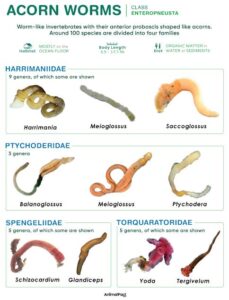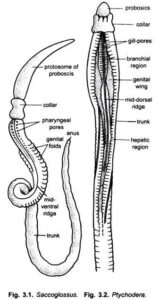Back to: ZOOLOGY 300 Level
WELCOME TO CLASS!
You’re welcome, my intelligent scholar! I’m happy you’ve joined today’s lesson—it shows your deep commitment to becoming an outstanding zoologist. Today, we’ll be learning about some strange but fascinating animals that are not very popular, but are extremely important to science. They’re called acorn worms. Don’t worry, they’re not the kind of worm you’d see in your garden or your plate of amala (laughs). These ones live in the sea, and even though they look simple, they have a lot to tell us about how animals like humans might have evolved.
Acorn Worms: Anatomy, Larval Forms, Phylogenetic Position
Anatomy of Acorn Worms
Acorn worms belong to a small group called Hemichordata. The name “acorn worm” comes from the shape of their head, which looks like the cap of an acorn seed. These worms live in U-shaped burrows in shallow sea water and feed by swallowing mud and filtering food from it.

Their body is divided into three parts:
- Proboscis – This is the front part that looks like a small knob or acorn cap. It helps the worm dig and also collects food.
- Collar – This connects the proboscis to the rest of the body and also contains the mouth.
- Trunk – This is the longest part of the body. It contains the organs for digestion, circulation, and reproduction.
Unlike earthworms, acorn worms don’t have a proper backbone, but they have some features that are similar to chordates—like gill slits and a structure that resembles a notochord.
Larval Forms
Acorn worms go through a larval stage before they become adults. Their larvae are called tornaria larvae. These larvae look very much like the larvae of echinoderms (like sea stars), which tells scientists that these groups may be closely related.
The tornaria larva is transparent, free-swimming, and has cilia (tiny hair-like structures) that help it move in water. After swimming around for a while, it settles down and transforms into the adult acorn worm. This change in body form is known as metamorphosis.
Phylogenetic Position
Now, this is where things get really interesting. For a long time, scientists didn’t know exactly where to place acorn worms. They don’t fully belong to chordates, but they also don’t fit with other simple worms. That’s why they were given their own group, Hemichordata, which means “half chordates.”

This means acorn worms are like distant relatives of chordates. They have some chordate-like features (like gill slits), but not all of them. They’re also closely related to echinoderms—like sea urchins and starfish—because of the similarity in their larvae. So, scientists believe that chordates, echinoderms, and hemichordates all came from a common ancestor. In the big animal family tree, acorn worms help us understand the early steps of how complex animals evolved.
Summary
- Acorn worms are marine animals found in shallow waters.
- Their body is divided into three parts: proboscis, collar, and trunk.
- Their larvae are called tornaria larvae, which resemble those of echinoderms.
- They belong to the group Hemichordata and are closely related to chordates and echinoderms.
- Acorn worms provide clues about the evolution of more complex animals.
Evaluation
- What are the three main body parts of an acorn worm?
- What is the name of the larval form of an acorn worm?
- Why are acorn worms called “half chordates”?
- Name one chordate-like feature found in acorn worms.
Every lesson brings you closer to becoming a well-grounded zoologist. Keep showing up, keep learning, and remember—Afrilearn is always here to support your journey to greatness. See you at the top!
